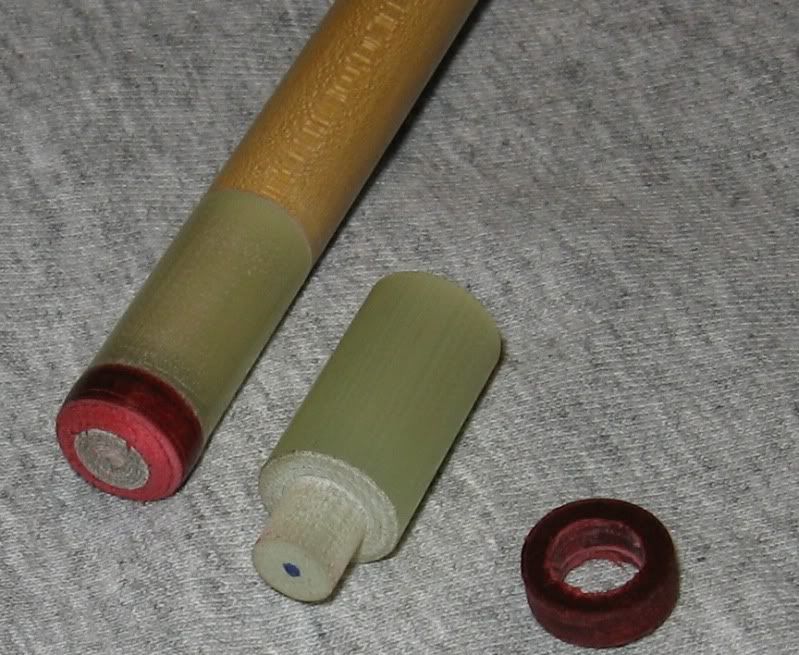You are using an out of date browser. It may not display this or other websites correctly.
You should upgrade or use an alternative browser.
You should upgrade or use an alternative browser.
Break/jump tip curvature
- Thread starter spktur
- Start date
dave sutton
Banned
Flatter the better to transfer as little English to the cue ball as possible. I go with Chris. About a quarter radius.
Flatter the better to transfer as little English to the cue ball as possible.
I've experimented endlessly with this & I find that you simply can NOT go too flat. The flatter the tip, the bigger the sweet spot & easier to park the rock. Try it totally flat...just knock the edge off a bit. I think you'll be quite pleased.
Below is a pic of one I made to skirt the law where phen tips are banned. Notice the phenolic core is absolutely flat. Works like a charm.:thumbup:
Attachments
I've experimented endlessly with this & I find that you simply can NOT go too flat. The flatter the tip, the bigger the sweet spot & easier to park the rock. Try it totally flat...just knock the edge off a bit. I think you'll be quite pleased.
Below is a pic of one I made to skirt the law where phen tips are banned. Notice the phenolic core is absolutely flat. Works like a charm.:thumbup:

Good Idea
Thats certainly a different way of doing it Chuck. I just thread the core down through the tip into the ferrule...makes it extremely durable. I developed this method for a few pros back during the IPT events where only leather was allowed & they had to jump full cue. I often wondered if anyone was suspicious from the loud "TINK" sound from supposedly leather tips...and some way too close jumps.:grin:
I do the same with my canvas tips...I machine a tenon on the back of the tip then thread it 5/16-18 down into the ferrule. That way there is never an issue of one popping off from the side shear force from a mis-hit...you can't even break the tip off the ferrule with channel locks.
May have to try some your way....looks quite a bit easier. :thumbup:
I do the same with my canvas tips...I machine a tenon on the back of the tip then thread it 5/16-18 down into the ferrule. That way there is never an issue of one popping off from the side shear force from a mis-hit...you can't even break the tip off the ferrule with channel locks.
May have to try some your way....looks quite a bit easier. :thumbup:
Last edited:
I've always thought the radius of the tip should be the same radius as the cue ball.
Correct. Unless...you are wanting to strike the cueball in such a manner as to impart no spin...or as little spin as possible.
I use my jumper as a regular cue, meaning when I shoot a jump
I want to play shape too.....
Whether that means stopping the cue ball or follow or draw...
You get the idea
I need some shape on the tip for that...... When customers buy my jumpers, I assume they want to jump like me so I shape em up the same as my personal cue
I want to play shape too.....
Whether that means stopping the cue ball or follow or draw...
You get the idea
I need some shape on the tip for that...... When customers buy my jumpers, I assume they want to jump like me so I shape em up the same as my personal cue
I use my jumper as a regular cue, meaning when I shoot a jump
I want to play shape too.....
Whether that means stopping the cue ball or follow or draw...
You get the idea
I need some shape on the tip for that...... When customers buy my jumpers, I assume they want to jump like me so I shape em up the same as my personal cue
I have to agree with this. For a BREAK cue, flatter is better, but for a jump cue, the same radius you use on your player is what I would recommend.
This is the reason that I would never use a "jump/break" I have a "jump/break" that is used for breaking, and a "jump/break" that is a dedicated jump cue (the extension piece has been lightened to an extreme extent (forward weight and overall cue weight of 13oz)... makes for the best dedicated jump cue I have ever used.
It allows me easy "short jumps" with the short cue, and full table jumps with a full length cue that jumps like most normal jump cues... but with more accuracy
